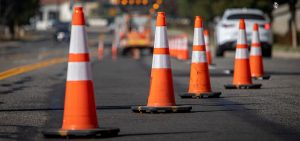Athens’ Herrold Avenue extension project is set to be completed by the end of November
By: Gabriel Scotto
Posted on:
ATHENS, Ohio (WOUB) – If all goes according to plan, another route to the West State Street ballfields, which are choked with traffic in the spring, will open soon.

“The goal of the project is multifold. Number one, it’s to promote economic development (on) Herrold Avenue,” said Athens Service-Safety Director Andy Stone. “The second thrust of the project is to allow for better circulation on the west side of the city.”
In total, the West Union Street Improvements Project will cost $7.5 million and will be completed in November 2024, with the Herrold Avenue connector being completed at the end of this month.
“The Herrold Avenue access road is part of a larger project. In order to do that project and maintain traffic through the west part of the city, the Herrold Avenue connector needs to be completed on the front end because it’s part of the maintenance of traffic scheme for that larger project,” explained Stone.
City Engineer and Director of Public Works Saleh Eldabaja says the city has worked to ensure that traffic in the areas where construction is taking place will continue to run smoothly.
“We understand that when you do a project like this, there’s impacts to the adjacent properties, businesses and also travelers coming in and out of the area,” said Eldabaja. “There’s an extensive traffic plan for this particular project and we’ll also give the contractor the flexibility during construction to adjust if anything comes up.”
Of the $7.5 million earmarked, $4 million will be covered by local funds, with the remainder paid for through a combination of low-interest loans from the Ohio Department of Transportation and funding from the Ohio Public Works Commission and the Appalachian Regional Commission.
“We’re going to incur some debt in order to complete this project,” said Stone. “Not so much the access road portion on Herrold Avenue, but certainly West Union Street, and that debt is something we’ll have to pay over time. But we think it’s worth it because West Union is an important arterial for the city and we need to spend money on the roadways that allow us to move people and commerce in the city.”
The West State Street Improvements Project not only includes the construction of the Herrold Avenue connector, but also pavement, new sidewalks, storm drainage and new water and sewer lines along West Union Street from Shafer Street to the bridge over the Hocking River.
The initial planned route for the Herrold Avenue extension was located farther east. However, this earlier route would’ve required acquiring property through eminent domain, something the City Council rejected. Therefore, the decision was made to build the extension on land the city already owned.
According to Stone, several existing businesses along Herrold Avenue have indicated they wish to make improvements to their properties. However, the most immediate beneficiaries of the Herrold Avenue connector will be Athenians who wish to access West State Street Park.
“There are a lot of users that use the West State Street Park and right now they’re kind of funneled through a neighborhood,” said Stone. “I would expect a good deal of the users that go to (the ballfields) will travel on West Union Street and then up Herrold Avenue versus what they do now, which is travel on West State Street to get there.”
Eldabaja reassured businesses and residents of Athens’ West side that the city is working to not only minimize disruptions to traffic, but also to those in the area.
“We put restrictions on how late (the contractors) can work with their equipment if they’re going to be working in a residential neighborhood,” said Eldabaja. “We also have a liaison on the project that’s going to be contacting the businesses and make sure that they have access during construction.”

